“I did not try to fool the history”, Expert Ysa Osman Testifies
Expert Ysa Osman was questioned by the defense teams for Khieu Samphan and Nuon Chea today. He was asked about his methodology of research and how he had tried to ensure that his insights were representative of the Cham population and the accounts accurate. Meanwhile, Mr. Koppe suggested that Hun Sen, Heng Samrin, Ouk Bunchhoeun and Sao Phim were those most responsible for crimes against humanity that allegedly occurred in Sector 21.
Submissions on request to call additional witness
At the beginning of the session, the Trial Chamber Greffier announced that all parties were present, with Nuon Chea following the proceedings from the holding cell.
The floor was granted to the Nuon Chea Defense Team to explain the importance of the witness. Defense Counsel Victor Koppe submitted that the witness was important not only for Mondulkiri but also for the whole Northeast Zone. The Defense Team had confronted other witnesses with this witness’s interview. Mr. Koppe argued that the witness could offer evidence about Vietnamese incursions and assistance by cadres and 801 soldiers to Vietnamese troops. The witness seemed to have put forward evidence, Mr. Koppe said, about the so-called Kham Phoun movement.
He said they were not sure yet whether E3/7960 was an accurate summary of his 23 March 2007 DC-Cam statement. Only a Khmer version available of this statement. Moreover, part of the request was triggered by the OCP request to admit 2-TCCP-1017. The witness that the Nuon Chea Defense Team requested to be heard had also been a Division 920 combatant and a former detainee.
Judge Jean-Marc Lavergne asked Mr. Koppe to clarify which segment this witness was most relevant. He said he did not see the relevance for Au Kanseng Security Center. Mr. Koppe replied that the witness was relevant for Phnom Kraol Security Center. Moreover, he said that there had been a geographical distinction between Mondulkiri and Rattanakiri, but that the Northeast Zone had been treated as one during Democratic Kampuchea. Further, he had relevant insight into rebellion movements, armed conflict in general and purges.
International Co-Prosecutor said they had no objection to calling the witness and admitting the DC-Cam statement, although their interpretation of the witness’s evidence was different. He also pointed out that the DC-Cam statement they had was from 2001 and not 2007.
The Civil Party Lead Co-Lawyers had no objection, nor did Khieu Samphan Defense Counsel Anta Guissé object.
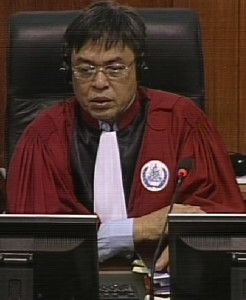
Trial Chamber President Nil Nonn
Mr. Koppe then asked for clarification regarding the testimony of the expert witness. He intended to confront him with the testimonies of 2-TCW-938 and 2-TCW-894, who had testified in closed session. He now asked whether he should proceed to ask the questions in open session or whether it should be held in closed session. Judge Jean-Marc Laverne asked why he asked this question only now, since he had known about the issue for a long time. Mr. Koppe answered that the testimony of the expert was only taking place now. The President announced that he should refer to this topic toward the end of questioning the expert. Judge Claudia Fenz clarified that these questions would be held in closed session.
Khieu Samphan Defense Counsel Anta Guissé asked for an update on witness 2-TCW-840[1] who still seemed to be unavailable. The President said more information would be provided later during the day.
Clarifications on background of expert and methods of research
The floor was granted to the Nuon Chea Defense Team to put questions to Ysa Osman. He asked whether it was correct that he wrote a third book called Navigating the Rift. The expert confirmed this, but said it was not related to the Khmer Rouge regime and was about the relationship of Cham people and Khmer people. Mr. Koumjian interjected and asked for citation. Mr. Koppe went ahead and asked the witness why he had not indicated having written a third book. At this point, Mr. Koumjian objected and said that an exact quotation with the question should be given. Mr. Koppe quoted the relevant part of the testimony, during which Mr. Osman had said that: “yes I have authored 2 books dealing with Democratic Kampuchea”.[2] Mr. Koumjian asked him to provide the question that had been put to Mr. Osman. Judge Fenz interjected and said that in any case, Mr. Osman had referred to books on Democratic Kampuchea.
Mr. Koppe rephrased his question and asked whether he had written a third book, which the expert confirmed. He explained that the question had not been about all the books he had authored but only about those related to Democratic Kampuchea.
Mr. Koppe asked whether it was correct that he did not attend any formal education in terms of for example a master degree after three years of studying English. He replied that he obtained a bachelor degree in English literature but did not pursue a master degree. He attended short training courses, but could not recall all of them. Some did not take place in a formal place, such as a school, but took place between his mentor and him. He also attended seminars.
Mr. Osman apologized and said he had a sore throat. He then explained that he had read books and met researchers, professors, and lecturers and asked them questions in relation to what he wanted to know, in particular during the time that he worked for DC-Cam.
Mr. Koppe wanted to know more about his expertise in demographics and asked whether he was taught any formal knowledge in demographics. Mr. Osman answered that he joined courses about compiling research and the like, but not medicine, for example. Mr. Koppe referred to his book Oukoubah, in which he had said that experienced researchers at DC-Cam taught him methodologies of research and how to avoid leading questions.[3] Mr. Koppe wanted to know what this meant. He replied that multiple choice questions should not be put to the witness. Instead, open questions should be asked to find out whether the facts were true or not.
Mr. Koppe inquired whether it was correct that he used very limited excerpts of the interviews he had made in his book The Cham Rebellion and not included the questions. It was therefore difficult to determine whether he had asked leading questions, Mr. Koppe said, and asked whether this was correct. Mr. Osman replied that this was correct and that he included the accounts of the witnesses without the questions to make it easier for the reader to understand. The interviewees agreed that this was an appropriate account of their experience. However, he had not asked them to put their thumb print. All interviews were recorded in an audiovisual way and available at DC-Cam.
Mr. Koppe referred to the Written Record of Interview of a woman who had spoken to Ysa Osman and who had also testified in court.[4] This witness, No Satas, had said that the account was not entirely consistent. Mr. Osman replied that he had observed that some witnesses who had been invited to court had given a different account in court. However, he had given choices for every witness to recall what they had said. Some witnesses could not speak Khmer well. He stressed that the interviews were recorded and that Mr. Koppe could listen to them.
Mr. Koppe moved on and asked whether it was correct that he interviewed around 97 people for his book The Cham Rebellion. The expert answered that he could not recall the exact number of interviewees he had met, but said that he accepted the figure suggested by Mr. Koppe. “Let me declare solemnly that I believed in my researches. It is reliable, accurate, just, and I did not try to fool the history. And what happened to Cham people did not limit to the stories in my book. There are many more experiences, stories of those people”, he said.
Basis for nationwide policy
Most of the people he had interviewed lived in Krouch Chhmar District. Mr. Koppe said that they had counted around 115 people interviewees, had used 17 other interviews and that he had used around 10 interviews in both books. Mr. Koppe inquired whether this was correct. He replied that a section also referred to the rebellion.
Mr. Koppe asked whether he was able to give an estimate how many Cham people were living in Cambodia when he conducted his interview. He answered that he had not conducted any research on this. He said that the history showed that Vietnam invaded Champa and killed Cham people. There were different stages that Cham people fled the “land of war”. Mr. Koppe interrupted the expert and repeated his question. He wanted to know how he established that the Cham people he interviewed were representative of the Cham people. He replied that around 200,000 Cham people were living in Cambodia after 1979. Mr. Koppe asked what his methods were to establish that the people he spoke to were representative of the around 200,000 Cham people in Cambodia, since he had said that a policy of genocide against the Cham existed. Mr. Osman replied that they had to set a specific number of people for that research. The account of those 100 or 200 interviews were consistent with accounts of other people. They had retrieved their information from four groups:
- victims
- those who worked during the Khmer Rouge regime
- contemporaneous documents
- previous research conducted by other authors
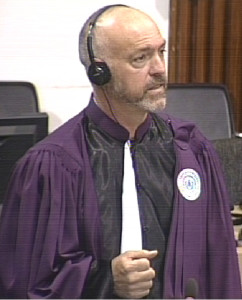
International Co-Prosecutor Nicholas Koumjian
Mr. Koppe queried whether he had spoken to Cham people from other regions to determine that there was a nation-wide policy against the Cham. At this point, International Civil Party Lead Co-Lawyer Marie Guiraud interjected and said that counsel was going “well beyond” the definition of genocide. She said she was not sure that the expert had said that they were dealing with a crime of genocide in the whole of Cambodia and not only a geographical genocidal policy. He would have to give precise references for this. Mr. Koppe replied that the witness had answered a question by the President saying that a policy of genocide had existed in Democratic Kampuchea. Mr. Koumjian stood up and said that all parties had agreed that the expert had not been allowed to give an opinion on whether a genocide existed.
Mr. Koppe found the excerpt and said that the President had asked about the policies of Democratic Kampuchea towards the Cham people, to which Mr. Osman had said that “I found that Cham people were gathered and brought for execution”, which did not indicate any geographical limitation.[5] After a brief exchange with the Co-Prosecutor, Mr. Koppe repeated his question to the expert how he ensured that his interviews were representative. Mr. Osman replied that he had limited his research to two areas and did not have the capability to conduct research in the whole country. This was focused on the East and the Central Zone.
At this point, the President adjourned the hearing for a break.
Lack of contemporaneous documents proving policy
After the break, the President announced that the defense teams had five more sessions to question the expert and that no reserve witness was scheduled for tomorrow.
The floor was then handed to the Nuon Chea Defense Team. Mr. Koppe turned back to the topic of the third book that Mr. Osman had written. The expert said that the third book focused on marriage between Khmer and Cham people and that the two groups did not discriminate against the other ethnicities. Mr. Koppe said that there was a paragraph on “The Erasing of Cham Identity” and asked whether it was correct that the book submitted that a genocide had taken place. Mr. Osman replied that it was inevitable to at least briefly address the Khmer Rouge regime.
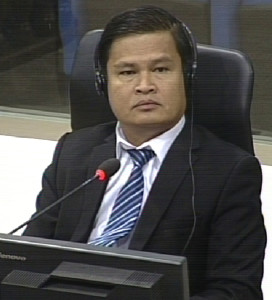
Expert Ysa Osman
Next, Mr. Koppe inquired whether it was correct that there was no single document that indicated a policy to erase the Cham. The expert replied that he had not been able to locate the documents in relation to such orders, but that he did not submit that these did not existed.
Mr. Koppe referred to The Cham Rebellion, in which Sos Kamry had given an interview. Mr. Koppe wanted to know whether it was correct that Sos Kamry was the most important source for Mr. Osman to indicate that there might have been a policy for smashing the Cham. Mr. Osman replied that Sos Kamry had said that he had seen a document in relation to this and that Saleh Ahmad had said having attended a meeting. Many other witnesses had said having seen such a document. Mr. Osman said that also telegrams proved that there was such a policy, although he had not been able to locate any documents.
Mr. Koppe wanted to know whether he encountered any S-21 document – such as confessions or guidelines – that could confirm that there was a document in relation to what should happen to the Cham. The expert replied that confessions and photographs of Cham people who were sent to S-21 survived. He said that S-21 was a prison to clean the highest-ranking officers of the Lon Nol regime and cadres. He had not been able to locate any document that showed the intent to erase the Cham population as such.
Mat Ly
Mr. Koppe then asked about Mat Ly. The expert confirmed having talked to him. Mr. Koppe asked him whether Mat Ly had not been a high-ranking cadre. Mr. Osman answered that he left to be a high-ranking cadre form 1978 onwards. Mr. Koppe requested leave to present Mr. Osman a copy of a few short biographies by the Vietnamese authorities and translated into German by the Stasi.[6] Mr. Koppe asked whether he agreed with him that the document he had put to him was a short biography of Mat Ly. The expert answered with a question and asked how he could know that it was Mat Ly, since the name was redacted.
Mr. Koumjian interjected and sought clarification whether it was the defense’s position that Mat Ly was the Deputy Chairman of the Committee of the Christian Khmer as indicated in the document, or whether the document was inaccurate. Mr. Koppe said that they could not be certain, but that the person had apparently indicated to the Vietnamese interviewer to be in that the position. The parents as indicated in this document were Sok Mak and May Nas. Judge Fenz intervened and asked what the purpose was of what counsel was doing, since he seemed to be testifying about why he thought that the person mentioned in the document was Mat Ly, while the witness had already said that he did not know. Mr. Koppe responded by saying that he was merely reacting to the Co-Prosecution’s interjection. Moreover, he pointed out that the second document was signed by a person called Mach Ly. Mr. Osman replied that it seemed to be Mat Ly he had interviewed, but there seemed to have been discrepancies. For example, the father of the Mat Ly he had interviewed was not called Sok Mak.
Mr. Koppe asked whether he knew anyone who “remotely looked like” the person in the document who was a Second Deputy in Tboung Khmum District in the East Zone other than Mat Ly. Mr. Osman asked what the purpose was of redacting the document and then showing it to him witness to confirm the identity if they knew it already. He confirmed that Mat Ly worked as a member of the district committee in Tboung Khmum in 1978. Judge Fenz interjected and explained that the document had not been redacted by counsel but had previously been redacted already.
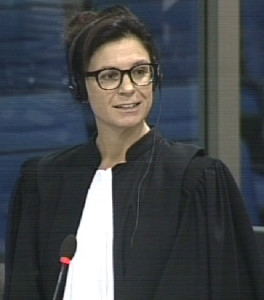
International Civil Party Lead Co-Lawyer Marie Guiraud
Mr. Koppe asked whether he heard – when speaking to Mat Ly or when reading any of his interviews – if Mat Ly knew of any document that indicated a policy against the Cham. Mr. Osman replied that he had not mentioned such a document. When Mr. Koppe asked whether he would agree that Mat Ly would have most likely known about such a document due to his position, International Civil Party Lead Co-Lawyer Marie Guiraud interjected and said that it was a leading question, since the expert had not identified the person of the interview. The witness said that he thought that the assumption was Mr. Koppe’s own conclusion. Mat Ly had not mentioned any such document, but that maybe such a document could have been concealed from him. Mat Ly had confirmed to him that Cham people had been purged at a large scale in the East Zone. He confirmed that Mat Ly was one of the “respected Cham people in Cambodia” and represented Cham people in the government after 1979.
Mr. Koppe moved on, saying that his “point was clear”. He wanted to know which troops were responsible for “apparently the killing of many Chams in October/November 1975.” When Mr. Osman did not directly answer the question, Mr. Koppe asked whether these were district, sector or zone forces. Mr. Osman replied that the Cham people first clashed with the troops from Krouch Chhmar District. Since the troops from Krouch Chhmar could not get into Koh Phal or Svay Khleang, other troops from the sector level came in. These troops came from Sector 21. Mr. Koppe asked whether his source was an interview of Man Zain.[7] Mr. Osman confirmed that this information was correct, but that also another witness, who was called Sen Kaup, also had provided this information.
Mr. Koppe referred to another person’s interview, who they had requested to appear before the Chamber (2-TCW-997). This person had said that sector troops of regiment 55 were involved in the crushing of the rebellions in 1975.[8] Mr. Osman said that the troops were from Sector 21.
Asked about Stephen Heder, he replied that he considered him as his tutor on the matter. Mr. Koppe asked whether he was an expert, in Mr. Osman’s opinion, on the structure of troops in the East Zone. Mr. Osman replied that he acknowledged that Mr. Heder had “great wealth of knowledge” and had respect for him in this regard.
Mr. Koppe inquired whether he had ever heard of an organization called Human Rights Watch, which the expert confirmed. Mr. Koppe wanted to know whether he was also aware of a report on the crushing of the rebellion in 1975 by Human Rights Watch, and if yes, whether he knew who the author was. At this point, Ms. Guiraud interjected and said that the document had been rejected and that therefore all questions relating to this document should be rejected.[9] Mr. Koppe replied that the document was in the public domain and was therefore entitled to ask the question. Mr. Koppe asked whether he knew of the report that the Defense Team believed to be authored by Stephen Heder. Mr. Osman replied that he had not read the report in detail. However, he had read newspapers which “gave some synopsis” of the report – either in Cambodia Daily or in the Phnom Penh Post. He remembered that the report said that the order to kill the Cham came from Sector 21.
Mr. Koppe asked whether he knew whether Ouk Bunchhoeun, Heng Samrin and possibly Hun Sen were responsible for the crushing of the rebellion. He answered that he had not mentioned any government officials in his book.
Sector 21
Before giving the floor to the Nuon Chea Defense Team, the Chamber asked whether they intended to put questions to the expert in relation to the two witnesses that had been subject of discussion earlier during the day. Ms. Guissé answered that she was going to ask about these persons, but that it was not necessary to resort to an in camera session. The floor was granted to the Nuon Chea Defense Team.
Mr. Koppe asked for additional time and sought to be able to finish, together with the Khieu Samphan Defense Team, their questioning tomorrow at lunch time. Ms. Guissé also said that the Khieu Samphan Defense Team needed three sessions instead of two as they had been allotted.
Mr. Koppe referred to Mr. Osman’s earlier statement that he had not mentioned any government officials in his two books and wanted to know the reasons for this. Mr. Osman replied that most people did not indicate any particular individuals. Thus, he did not include any names. He would have included those people’s names that were mentioned. Mr. Koppe said that there was a long chapter on Sector 21 and the East Zone. Mr. Koppe further said that it was quite well-known who the East Zone leaders, the secretary of Sector 21 and the deputy were and the military leader in Sector 21. Mr. Koppe pressed on the issue and asked why he did not mention governmental officials: “Is that maybe because you are afraid to do so?” Mr. Osman denied this and said that his research had its limits. There may have been some individuals who are now working in the government and may have been related to Khmer Rouge activities. While working at DC-Cam, he had written a letter to request an interview with government officials, but he had not received any response. Mr. Koppe asked whether it would be helpful for Mr. Osman to ask these questions in closed session. Mr. Osman said that the OCIJ legal officer could answer the question. The President said that he could consult with the legal officer who was sitting next to him, Julie Bardeche, and inform the Chamber about the decision. Mr. Osman said that in relation to killings of Cham by government officials, he would object to answer the question. Mr. Koppe said that to his understanding, Mr. Osman was not allowed to decline to answer as long as the subject did not relate to Case 003 or 004, which he argued were not investigating this topic. The President announced that the expert had to answer questions related to his expertise. He pointed out that they could not force him to give an answer beyond his expertise, so he could say that he did not know.
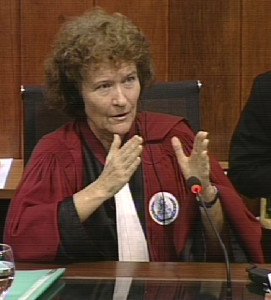
Judge Claudia Fenz
Judge Fenz said that certain requirements had to be met and that he would have to tell the Chamber that he felt threatened if he requested a closed session.
Mr. Koppe said that the three villages he had written about were in Sector 21 and lay in his expertise. Moreover, Stephen Heder had been his mentor. He asked for his reaction to Mr. Koppe’s allegation that Ouk Bunchhoeun, Heng Samrin (chief of military staff), Sao Phim (East Zone commander) and Hun Sen were all responsible for crimes against humanity. Mr. Koumjian interjected and observed that this had been a lengthy introduction to the question. The National Deputy Co-Prosecutor asked for the source that governmental officials were responsible for crimes against humanity. Mr. Koppe repeated that it was his position that these four people were the ones mainly responsible for the crimes committed and sought Mr. Osman’s expert opinion on this. Mr. Osman replied that none of the people he interviewed expressly mentioned the names or only mentioned that they were part of the leadership. They had not mentioned that they were implicated in the killing of the Cham. He said it was better to summon these people, since they were survivors. Mr. Koppe laughed and said that it was his “favorite hobby” to ask for the summoning of these people.
Rebellion movements
Mr. Koppe read out an excerpt of an interview of Ouk Bunchhoeun by Stephen Heder.[10] Mr. Koumjian objected and said that the information might have come from a confession. Mr. Koppe said that they were only prevented from asking a question when there was a real risk of stemming from a confession.[11] Mr. Koppe then continued reading the excerpt that talked about the FULRO movement. Mr. Koumjian said that there was a burden by the party that proposed to use the evidence that the information did not come from torture. Counsel had already said that he did not know where the information came from. Mr. Koppe replied that they had asked Ouk Bunchhoeun to be summoned already six times, which was how they could see whether this information came from confessions and torture or not.
After conferring with the bench, Judge Fenz asked Mr. Koppe to refer back to the part in which it was said that it was based on confessions, which Mr. Koppe did. International Civil Party Lead Co-Lawyer Marie Guiraud said that the decision by the Chamber set out that all security centers posed a real risk of torture. Mr. Koppe said that if he remembered correctly, Krouch Chhmar was not included under the list of security centers that had a predisposed risk of torture.[12]
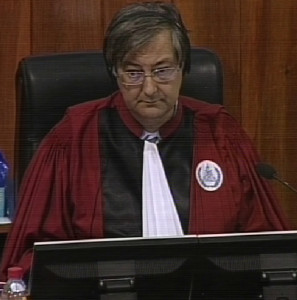
Judge Jean-Marc Lavergne
The bench conferred for a few minutes. The floor was then given to Judge Lavergne. He announced that the practice of torture was a general practice and applied in all security centers under Democratic Kampuchea, including Krouch Chhmar. If the information he wanted to rely upon came from confessions from Krouch Chhmar, there was a pre-disposed assumption of torture and the defense would have to convince the Chamber of the contrary. Mr. Koppe said he did not understand the decision. He then asked Mr. Osman whether he knew anything about Krouch Chhmar center. He replied that people involved in the Koh Phal rebellion were not detained at Krouch Chhmar, but those at Svay Khleang were. Mr. Koppe then wanted to know whether FULRO was involved in the 1975 rebellion. He replied that FULRO had a clear intention. FULRO not only supported the Cham but also the previous government that existed before 1970. One FULRO tried to liberate Champa from Vietnam and another FULRO tried to liberate an area in lower Cambodia.
Les Kosem was part of the military and a leading general under Lon Nol. He was an ethnic Cham and part of the FURO movement.
Mr. Koppe referred to another document and sought more information about FULRO.[13] Mr. Osman replied that he did not go into detail of the political motivations behind this. He explained that he had not done any research of the relation between the three villages and Les Kosem.
Mr. Koppe turned to a rebellion organized by the White Khmer. He asked whether his understanding was correct that he only done limited research about the existence of the White Khmer, which the expert confirmed. Mr. Koppe asked why he had not gone into detail with this movement, since 21 Civil Party documents had mentioned the White Khmer and made a connection to the rebellion. Ms. Guiraud replied that many of these applications had not been admitted and a few of them might have mentioned them, but not made a connection to the rebellion. Judge Fenz asked Mr. Koppe to provide accurate reference.
Mr. Osman said that some Cham people had said that some were accused of being White Khmer and killed because of that. Others were accused of being KTB or CIA agents. He therefore did not need to go into further detail, since it was just “a pretext to kill the Cham”, the expert said.
At this point, the President adjourned the hearing for a break.
Methodology
In the last session, the Chamber informed counsel Koppe that he would be allowed to put questions to the witness in closed session about the Written Record of Interview or testimonies of the two witnesses that he wished to refer to. Mr. Koppe requested another extension of time. Ms. Guissé said that they should combine the closed sessions. Judge Lavergne sought more clarification. International Co-Prosecutor said that if additional time was granted to the defense, additional time should also be granted to the Prosecution. National Civil Party Lead Co-Lawyer Pich Ang said that the practice set out that the Chamber was usually strict with regards to time limits and that the time allotted to the defense teams had already been sufficient.
After deliberating with the bench for approximately ten minutes, the President announced that the Co-Prosecutors could have one session after lunch break and then the two defense teams could have the closed session as the last session in the afternoon.
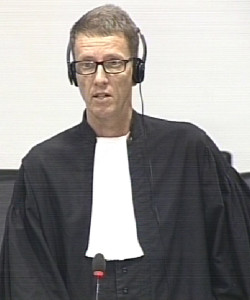
International Nuon Chea Defense Counsel Victor Koppe
Ms. Guissé then started her line of questioning. She requested leave to present a folder with several documents to the witness, which was granted.[14] The witness confirmed that he had already worked for DC-Cam when writing Oukoubah. She wanted to know whether he had written or read the excerpt when the book was published.[15] He confirmed that he had read it. He had not written this segment. Sim Sorya had shown the text, but the expert was not sure who had written it. They were instructed to avoid posing leading questions to witnesses. She wanted to ask whether he had “learned on the job” in terms of research methodology, which the witness confirmed. He did not have any professors or assistants with him during the interviews. When he interviewed Mat Ly, Sim Sorya was with him. She pointed to interviews of several people at the same time and asked whether there was not a risk that he ended up in a situation where there is a leading interview because of the involvement of other people. [16] He replied that the interview she referred to was the interview of Chan Thea, which did not – according to Mr. Osman – relate to the research on Cham. He recounted that the interviewees were allowed to select who was the representative of the group and who remembered the most. There were occasions, in which co-interviewees added information. He interviewed one individual on different occasions. He did not ask him or her why that person gave a different account on different days. He further said that he quoted a story of individuals he had interviewed in one section of his book. The stories about the rebellions, detentions and killings, he said, were consistent. She referred to an excerpt of his book Oukoubah, in which No Satas had given an interview.[17] At another time he had talked about a hundred people.[18] He replied that the information he indicated referred to specific individuals. When they appeared before the Chamber and tell a different story, Mr. Osman said, it was their own responsibility. He said that the memory changed over time. He interviewed them around ten years ago, so “they may have remembered not well, and if you do not believe me, you can invite them to talk”.
Ms. Guissé said that the figures “do not come out of the blue” but originated from other interviews. She wanted to know why there were different figures in his book than in his interviews. He requested the pages to be able to compare the relevant figures.[19] He replied that this draft was not published. The official information was the figure from the book that he had published. He said that when comparing some information from the original Khmer draft was not consistent. The publication was done by DC-Cam staff members. She wanted to know whether the document that was in the annex and had forty names on them was not accurate. He answered that the draft manuscript was not the official publication. In relation to the figure 40, he said that this did not refer to the people who were sent away to be killed, but to the group of single women. She repeated her question and wanted to know where he had retrieved the number of 100 Cham. She gave the reference.[20] He said that the figure quoted the interview of the 5th of December who had mentioned the number of roughly 100 Cham.
The President adjourned the hearing. It will continue tomorrow, March 24 2016 at 9 am with the testimony of Ysa Osman.
[1] This was an interpretation error and translated as 2-TCW-140.
[2] February 9 2016.
[3] E3/1822, at page 161, 00078599 (EN).
[4] 00274703 (EN), 00224113 (FR), 00204445 (KH).
[5] Testimony of Ysa Osman, February 9 2016, at 09:46.
[6] E3/9720, 01206330 (EN) and 01206360 (EN), 01002049 (GER), 01002063 (GER).
[7] At 0022181859 (EN), 00221853 (KH), 00293925 (FR)
[8] E3/5261, at 00274336 (EN), 00285329 (FR), 00250947 (KH).
[9] E347/4.
[10] E3/387, 00379487(KH), 00350206 (EN), 00441418-19 (FR).
[11] At 15:43.
[12] E350/8, at paragraph 79.
[13] E3/9359
[14] E3/511, E3/1822, E3/7525, E3/2649
[15] E3/1822, at 00078597-99 (EN), p. 149.
[16] E3/7525.
[17] At 0000784.
[18] 00224115 (FR), 00204448-49 (KH), 00204453 (EN).
[19] E3/9333, annex of No Satas.
[20] 00078597 (EN), page 6.
Featured Image: Expert Ysa Osman and legal officer Julie Bardeche

[…] See also I did not try to fool the history, Expert Ysa Osman Testifies, The Cambodia Tribunal Monitor, March … […]